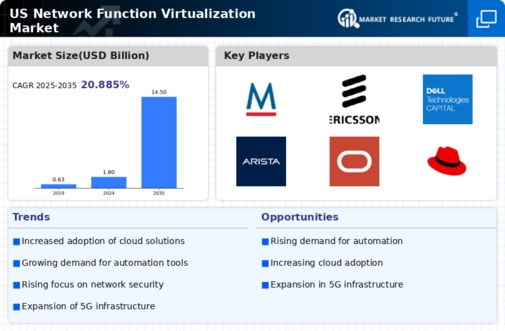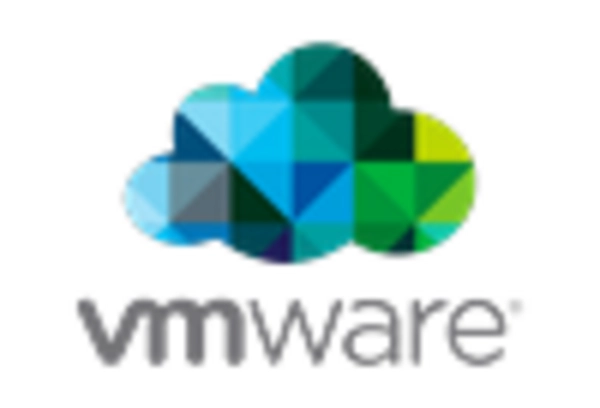The network function-virtualization market is currently characterized by a dynamic competitive landscape, driven by rapid technological advancements and increasing demand for efficient network management solutions. Key players such as Cisco Systems (US), VMware (US), and Nokia (FI) are at the forefront, each adopting distinct strategies to enhance their market positioning. Cisco Systems (US) focuses on innovation through its robust portfolio of software-defined networking solutions, while VMware (US) emphasizes partnerships and integrations with cloud service providers to expand its reach. Nokia (FI), on the other hand, is investing heavily in research and development to enhance its 5G capabilities, thereby solidifying its competitive edge in the market. Collectively, these strategies contribute to a competitive environment that is increasingly centered around technological innovation and strategic collaborations.
In terms of business tactics, companies are increasingly localizing manufacturing and optimizing supply chains to enhance operational efficiency. The market structure appears moderately fragmented, with several key players exerting considerable influence. This fragmentation allows for a diverse range of offerings, yet the collective strength of major companies like Cisco Systems (US) and VMware (US) shapes the competitive dynamics significantly, as they leverage their resources to capture market share and drive innovation.
In October 2025, Cisco Systems (US) announced a strategic partnership with a leading cloud provider to enhance its network function-virtualization solutions. This collaboration is expected to streamline service delivery and improve customer experiences, indicating Cisco's commitment to integrating cloud capabilities into its offerings. Such partnerships are crucial as they not only expand market reach but also enhance the technological robustness of their solutions.
In September 2025, VMware (US) launched a new suite of virtualization tools aimed at optimizing network performance for enterprises. This initiative reflects VMware's focus on addressing the growing demand for agile and scalable network solutions, positioning the company as a leader in the digital transformation space. The introduction of these tools is likely to attract a broader customer base, further solidifying VMware's market presence.
In November 2025, Nokia (FI) unveiled its latest advancements in 5G network function-virtualization, showcasing enhanced capabilities for real-time data processing. This development underscores Nokia's strategic emphasis on 5G technology, which is pivotal for future network infrastructures. By prioritizing 5G, Nokia is not only enhancing its product offerings but also aligning itself with the future demands of the telecommunications sector.
As of November 2025, the competitive trends in the network function-virtualization market are increasingly defined by digitalization, sustainability, and the integration of artificial intelligence. Strategic alliances are becoming more prevalent, as companies recognize the need for collaborative approaches to tackle complex challenges. Looking ahead, competitive differentiation is likely to evolve, shifting from traditional price-based competition to a focus on innovation, technological advancements, and supply chain reliability. This transition suggests that companies will need to invest in cutting-edge technologies and sustainable practices to maintain their competitive edge.

















Leave a Comment